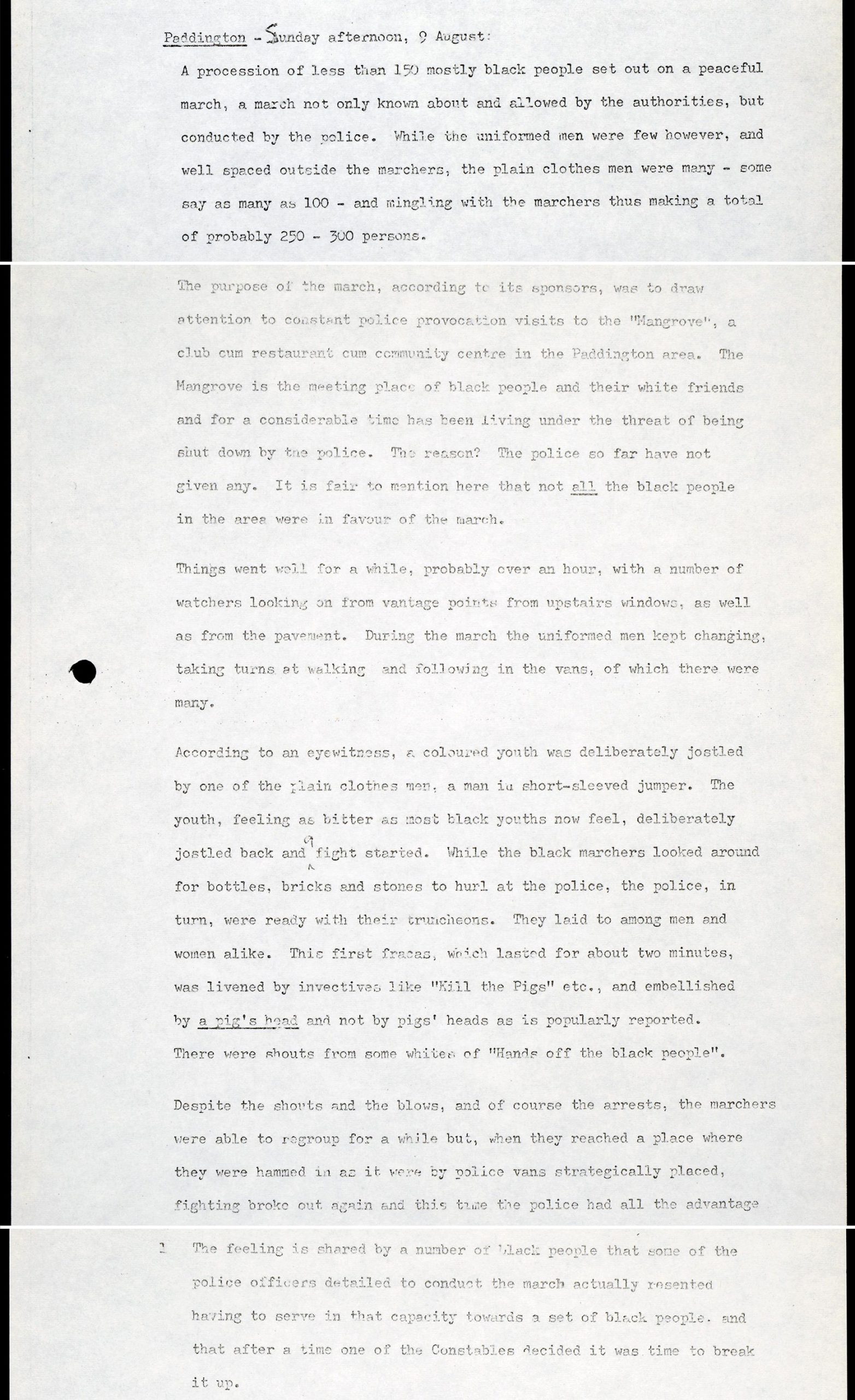
Extract from ‘Report on Police/Immigrant Relations’ by Sam Morris, 17 August 1970. Catalogue ref: HO 325/143, pp. 3-5
Sam Morris (b.1908-d.1976), deputy-general of the Community Relations Commission was asked to write a report for the Home Secretary a week after the protest. According to Morris, this report was ‘based on eyewitness accounts. Some of those to whom I spoke are known to me personally and are quite reliable.’
The Community Relations Commission, established by the 1968 Race Relations Act, sought to promote good ‘community relations’ between black and minority ethnic communities and white people in Britain. Sam Morris was a Grenada-born educationalist, anti-colonialist and civil rights activist. He first came to London in 1939. After serving in the British Army for two and half years during the war, he soon began working to support the welfare of New Commonwealth Immigrants in Britain.
Transcript
A procession of less than 150 mostly black people set out on a peaceful march, a march not only known about and allowed by the authorities, but conducted by the police. While the uniformed men were few however, and well spaced outside the marchers, the plain clothes men were many- some say as many as 100 and mingling with the marchers, thus making a total of probably 250-300 persons.
The purpose of the march, according to its sponsors, was to draw attention to constant police provocation visits to the “Mangrove” club cum restaurant cum community centre in the Paddington area. Mangrove is a meeting place of black people and their white friends and for a considerable time has been living under the threat of being shut down by the police. The reason? The police so far have not given any. It is fair to mention here that not all the black people in the area were in favour of the march.
Things went well for a while, probably over an hour, with a number of watchers looking on from vantage points from upstairs windows, as well as from the pavement. During the march the uniformed men kept changing, taking turns at walking and following in the vans, of which there were many.
According to an eyewitness, a coloured youth was deliberately jostled by one of the plain clothes [police]men, a man in a short-sleeved jumper. The youth, feeling as bitter as most black youths now feel, deliberately jostled back and a fight started. While the black marchers looked around for bottles, bricks and stones to hurl at the police, the police, in turn, were ready with their truncheons. They laid to among men and women alike. This first fracas [fight], which lasted for about two minutes, was livened by invectives [insulting language] like ‘Kill the Pigs’ etc., and embellished [exaggerated] by a pig’s head and not by pigs’ heads as is popularly reported. There were shouts from some whites of “Hands off the black people”.
Despite the shouts and the blows, and of course the arrests, the marchers were able to regroup for a while but, when they reached a place were they were hammed in as it were by police vans strategically placed, fighting broke out again and this time the police had all the advantage.
The feeling is shared by a number of black people that some of the police officers detailed to conduct the march actually resented having to serve in that capacity towards a set of black people, and that after a time one of the Constables decided it was time to break it up…
Tasks
- Which line in the report says that the march was permitted by the authorities and police?
- Are there any examples of police violence in Morris’ report?
- Can you explain what Morris is attempting to achieve by this report to the Home Office?
- According to this source, how were women in the demonstration treated?
- Do you think white women would face similar treatment at this time?
- What derogatory term is used for the police in Sources 4, 5, 6? Can you find out the origin of this term?
- Evaluate whether Sources 4, 5, 6 about the Mangrove demonstration tell the same story. How do they differ? Which source do you find the most reliable or convincing? Justify your answer.
